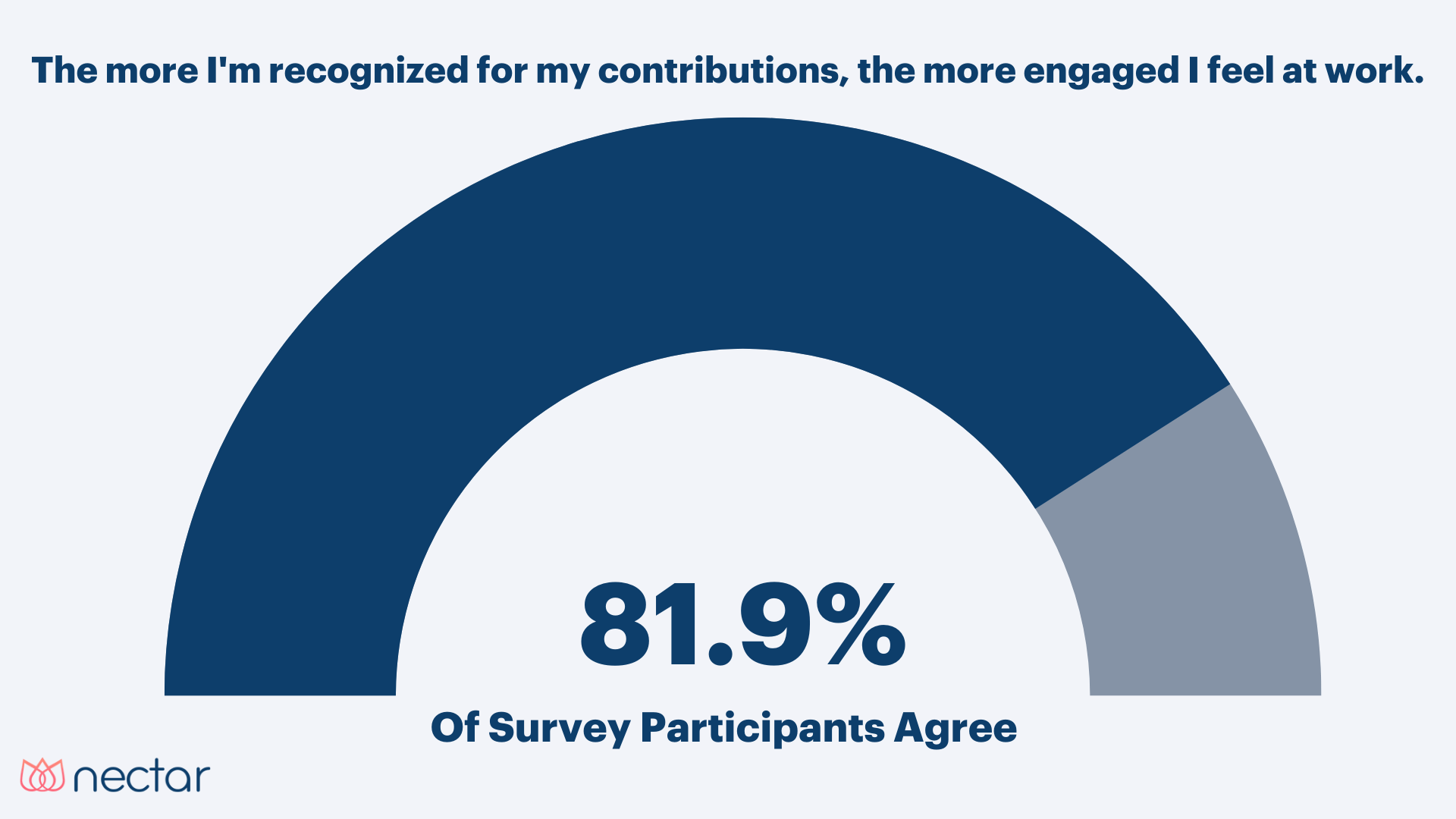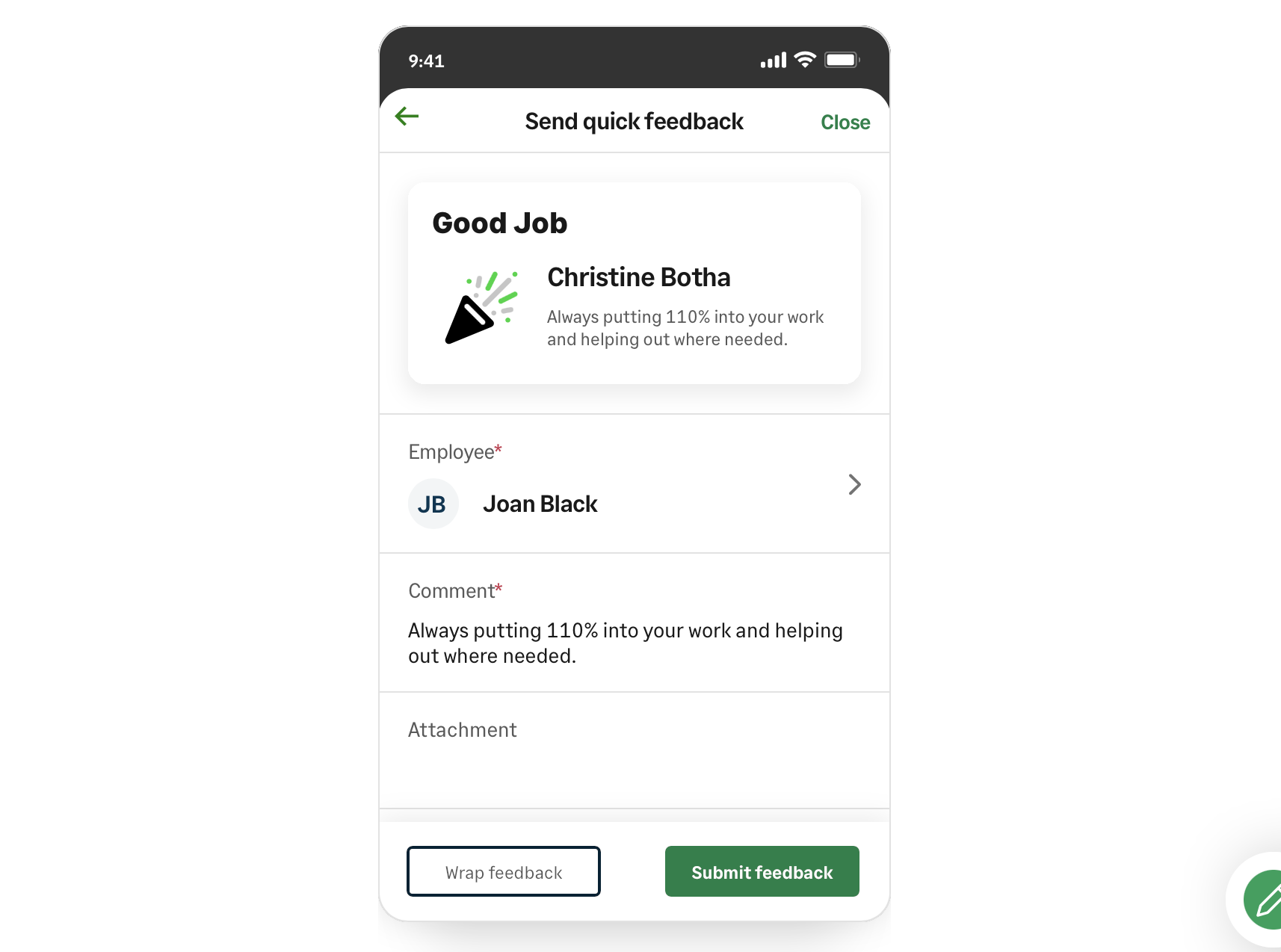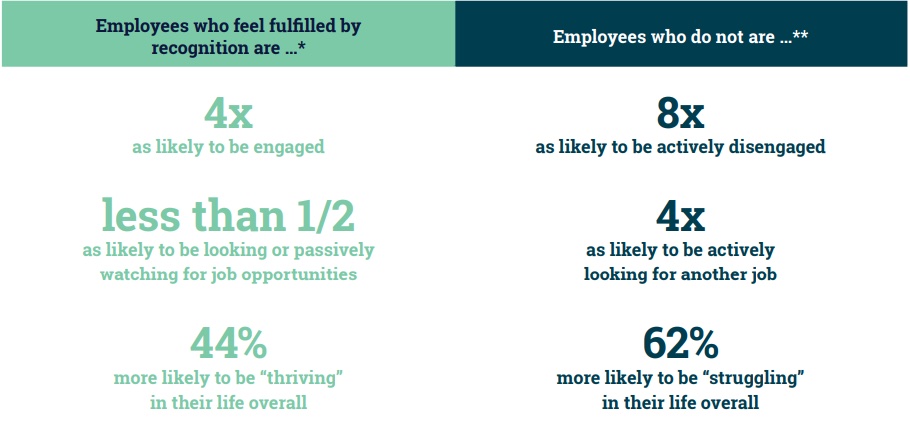Conducting a content team productivity assessment is a great place to start, as it helps you identify obstacles that are blocking optimal productivity levels. Upskilling, collaboration, and a robust tech stack can all boost productivity, too.
And, of course, monetary and non-monetary incentives are the ultimate motivator. In fact, a recent survey by Nectar found that for almost 82% of employees, receiving recognition directly increases their engagement.

Image sourced from nectarhr.com
With that in mind, let’s explore how you can boost your content team’s productivity in a little more depth, starting with a productivity assessment.
Content team productivity assessment
Evaluating the current productivity levels of your content team helps you establish a productivity baseline and establish KPIs for the future. More importantly, it’s beneficial for uncovering hidden weaknesses within your team.
Skill gaps, knowledge gaps, internal conflict, poor collaboration—there are a host of issues that can hinder performance and efficiency. A thorough productivity assessment highlights these barriers and guides you toward a resolution.
For example, you might remove productivity obstacles by investing in training, removing knowledge silos, building team relationships, or leveraging the right technologies to connect international teams.
We’ll explore some of these solutions in more depth later. But first, how do you conduct a content team productivity assessment?
There are a few ways of doing this, including:
- Conducting on-the-job observations.
- Creating formal questionnaires.
- Utilizing 360-degree feedback.
- Tracking and analyzing productivity using performance software.
Productivity incentives
Recognizing and rewarding employees when they hit pre-set productivity targets can boost engagement and motivation. Incentives can be monetary (such as bonuses, commissions, or profit-sharing), or non-monetary (such as extra leave, recognition, or fringe benefits).
While monetary rewards might be 20% more effective than a passive “thank you,” don’t underestimate the worth of non-monetary rewards. Fringe benefits, public recognition, and flexible working are incredibly valued by employees for their authenticity and personalization.
Consider using a HR app to keep track of employee absences and track clock-in/clock-out times. The great thing about an app is that it can be accessed from anywhere, so employees can take advantage of flexible working and keep track of their own hours whether they’re working in the UK or the US. At the same time, you can also easily see who’s been putting in the extra effort and recognize their achievements.
And as an added bonus, advanced HR apps allow you to share immediate feedback and deliver recognition to employees as a productivity incentive.

Screenshot Sourced from sage.com
Other options include using employee monitoring software to track the real-time productivity of your employees. But it’s worth noting that you can’t gloss over productivity obstacles with incentives alone.
If there are more complex issues at play, such as internal conflicts or burnout, incentives may only temporarily increase productivity. This is why performing an assessment first is critical to identify and resolve core weaknesses.
Defining clear performance metrics
Performance metrics measure whether your employees are meeting specific targets. When you communicate clear performance metrics and set realistic targets, you eliminate confusion and give employees a unified goal to strive towards, which can improve productivity.
Content teams that are failing to meet targets may be hitting obstacles that are hindering their productivity. Using content analytics and other performance metrics, you can quickly identify underperformance and implement strategies to drive productivity into these areas.
For example, a content team that isn’t meeting project deadlines may need better collaborative software. If SEO strategies are failing, you might need to close a skills gap by investing in employee training.
Which brings us onto our next point…
Training and skill development
Training and upskilling increases the capabilities of your employees, which tends to naturally improve productivity. But the productivity-enhancing power of training and upskilling extends beyond simply upgrading your team’s skills.

Free to use image sourced from Unsplash
In fact, one study showed that 76% of employees are more likely to stay with a business that offers continuous training. All in all, learning and development increase employee well-being and job satisfaction—and happy employees are productive employees.
So, provide your team members with valuable, consistent training and upskilling opportunities, and they’ll reward you by being more engaged, motivated, and loyal—alongside being more capable.
Knowledge sharing and team collaboration
Knowledge hoarding is a disruptive force that drains productivity. It often presents itself within competitive, uncollaborative team cultures and can lead to productivity-hindering knowledge gaps, inefficient workflows, team conflicts, and impaired problem-solving.
However, when employees understand the value of working together to meet shared goals, productivity can flourish.
By creating a culture that embraces knowledge-sharing and collaboration, you can strengthen team relationships and close knowledge gaps. This leads to more effective, innovative problem-solving and the creation of more informed content strategies.
For example, you can unite your content marketing and social media strategies by combining the knowledge and skills of your website and social media content teams.
A productivity-boosting culture of knowledge-sharing and collaboration can be fostered by:
- Creating an internal knowledge-sharing platform.
- Encouraging and incentivizing judgment-free idea-sharing.
- Using collaboration tools to enable teams to work on projects synergistically.
- Implementing an open-door policy.
- Leveraging communication tools to improve team collaborations (particularly if you have remote employees).
- Considering peer-to-peer mentoring to simultaneously improve knowledge-sharing, build team relationships, and encourage collaboration.
Incentivizing high performance
Along with incentivizing productivity, you can also recognize and reward high-performing peers.
Performance incentives don’t just motivate employees to show up—they motivate them to thrive. Knowing that their hard work is acknowledged, appreciated, and rewarded can be the fuel they need to produce high-quality content that meets and exceeds targets.
According to a joint Workhuman and Gallup study, employees who receive recognition for their hard work are 4x more likely to be highly engaged. Moreover, they’re 44% more likely to thrive both in and outside of work.
On the flip side, employees who don’t receive recognition are 8x more likely to be disengaged at work and 4x more likely to look for another job.

Image sourced from workhuman.com
You can incentivize high performance by offering a range of monetary or non-monetary rewards as part of your employee incentive program. Some popular incentives that you could offer include:
- Cash bonuses.
- Profit sharing.
- Gym memberships.
- Paid vacation days.
- Discounts, gift cards, and subscriptions.
- Better health insurance.
- Tuition assistance.
- Private or public recognition.
- Charitable donations.
Whatever incentives you include, ensure that they are fulfilling and genuine. There’s no point rewarding employees with things they don’t want or need or going back on promised incentives.
Moreover, for an incentive program to succeed it should be embedded in the company culture and distributed fairly among each employee, regardless of their experience, level, or time at the company.
Always speak to your employees to understand what types of recognition they value the most.
Leveraging technology
Super-efficient content teams all have one thing in common: they leverage modern tools to streamline their workflows. One of the most invaluable technologies used by content teams today is a content management system—for example, Concrete CMS.
A content management system, or CMS, enables you to effortlessly create, edit, organize, collaborate on, and publish content. Not only can you store all of your digital content in one easily accessible place, but you can design workflows and use robust scheduling capabilities to streamline and automate collaborative content management.
Having the right CMS is a must for boosting content team productivity. Other technologies, like grammar, spelling, and SEO tools, can also make creating high-quality content easier and faster.

Free to use image sourced from Unsplash
But it doesn’t end there. Other tools, like accountancy software, also play a key role in boosting long-term content team productivity.
Paying your employees late—or paying them the incorrect amount—is a fast track to reducing productivity. Accounting software streamlines your payroll, calculating salaries and bonuses in seconds to eliminate human error and empower you to pay your people correctly and on time.
Also, because payroll legislations differ around the world, accounting software keeps you compliant regardless of where your employees are based. For example, if you have UK-based employees, accounting software will ensure that they’re paid the right entitlements and taxes in compliance with HMRC. And for employees in the U.S., accounting software allows you to stay compliant with IRS.
The more confidently employees trust your payroll, the more satisfied and loyal they’ll be to their role—and, as a result, the more productivity they’ll exert.
Tracking progress
When teams can’t see the progress they’re making on a project, it can make them feel as though they’re traveling down an endless tunnel. Which, needless to say, isn’t very motivating. It can also create unnecessary delays triggered by confusion over a project’s status.
With the help of a project management tool, you can provide content teams with a high-level view of their projects. This keeps teams on track, enabling them to see exactly where they are in the project lifecycle as well as the steps they need to take to reach their goal.
As a result, they’re able to work more purposefully and productively.
Final thoughts
Empowering your content team to create consistently excellent content means prioritizing their work wellbeing.
Incentivizing hard work with rewards and recognition is central to job satisfaction and can single-handedly increase engagement and productivity. This goes hand-in-hand with fostering a culture of knowledge-sharing, collaboration, learning, and development.
By taking this holistic approach and arming yourself with the right digital tools, content teams can streamline their workflows and scale productivity to new heights.





